What pipes are needed to give: plumbing and plumbing
The suburban area can be called a special place of residence, but, nevertheless, the summer plumbing of plastic pipes, as well as the sewage system is almost no different from any other, mounted for domestic use. The material from which these pipes are made may be different, these are PND - PVC, PE for low-pressure water lines and sewage systems and polypropylene with metal-based laminate for water supply (cold, hot) - here, of course, you can add steel and asbestos cement (chrysolite cement), but it is more commonly used in industrial facilities.
Below we will talk about the characteristics and methods of installation of such pipes, as well as see the video in this article, which will cover our topic more.
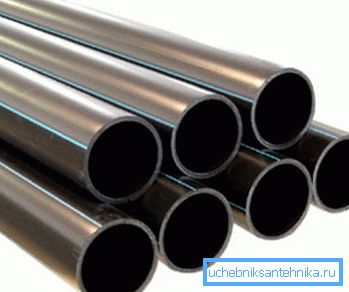
Country plumbing
Note. In this article we will consider only the direct appointment of pipes for the installation of plumbing, for example, HDPE pipes for water supply at the dacha are not always suitable, as they are not pressure, therefore, they can be used only with autonomous water intake (submersible pump, hydrophore). Or PE can be used as a tap from a city highway, where the pressure is not more than 0.03-0.1 MPa - 0.3-1.0 atmospheres (maybe up to 0.6 MPa - 6 atmospheres).
The same can be said about the pipes for gas in the country, for which use rubber, rubber-polymer and bellows sleeves, but they are not used for plumbing, despite the fact that in principle this is possible.
Specifications
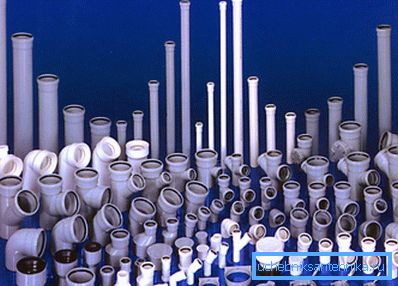
- Most often pipes for ditches in the country are used from polyvinyl chloride - at the household level, a diameter of 100 mm and 150 mm is used here (in rare cases 200 mm and 250 mm), and this ditch can be used both for wastewater from the house and as precipitation for precipitation (or both). Such non-pressure elements can have a flange or socket connection, but for such diameters only a socket is possible, in which the other end is fixed with a rubber sealing ring.
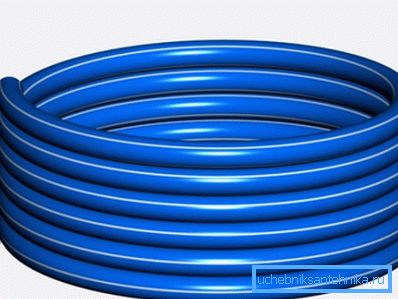
- If you have a well on the site, the HDPE water pipes for gardening can be made of polyethylene, however, it is this material that is usually used to supply water by a submersible pump or hydrophore (surface pump) to the distribution unit. In those cases when a high-pressure water line (up to 0.6 MPa 6 atm.) Passes near the house, PE cannot be used, as it simply will not survive.
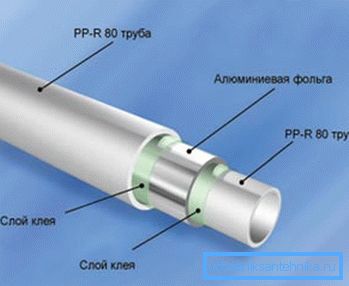
- Today, polypropylene or ecoplast, which is produced for both cold and hot water, is most often used for distributing indoor water.. For hot water, including for distributing heating, they produce reinforced pipes, where either aluminum foil or fiberglass can be used as a frame (for fiberglass the price of the product is higher). But most plumbers do not use unreinforced pipes, even for cold water, due to their thin walls.

- When plumbing is done, so to speak, in haste, then for internal wiring, you can use plastic pipes that are suitable for both cold and hot water. The main disadvantage of this material can be called metal fittings, which are amenable to corrosion and, therefore, become unusable. However, if you chose a metal-based laminate, it is best to choose a seamless version (foil without a seam — one piece or overlap), but check it visually — the manufacturer’s instructions sometimes cheat.
Installation
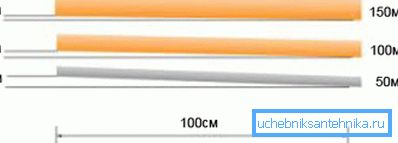
As already mentioned, PVC pipes that fit the trench are the most suitable for sewage, and the upper wall of the pipeline at any point should be at least 10 cm below the ground freezing point. In addition, the installation must comply with the mandatory slope, the norms of which you see in the upper image. Assembly is carried out using fittings. As well as rubber reductions and sealing rings.

Council In some cases, the rubber rings are very rigid and it is difficult to dock. To facilitate the task, I rub the end of the pipe or the ring itself with household liquid detergents.

Polyethylene pipe with a diameter of 32 mm to supply water to the house is also placed in a trench - in this case, you can arrange heating of the water supply pipes in the country with a heating cable or warm it with mineral wool, polystyrene foam or polyethylene foam, but it is much cheaper to go below the freezing point of the soil. PE joining is carried out by compression fittings, as shown in the upper figure, and the fitting can be not only straight, but also angular.
Note. All pipelines in the trench are laid on a sand cushion, and the HDPE is also covered with sand from above to avoid damaging the walls with sharp objects (stones, metal, glass).

Polypropylene pipes for plumbing in the country with their own hands are joined with a special soldering iron and fittings of a homogeneous material - the connection is very durable and withstands the same pressure as solid walls.
This type of wiring is convenient because even when external mounting it looks quite aesthetically pleasing and is attached to the wall (floor, ceiling) with metal or plastic clamps or clips. Polypropylene is also made cranes, which are usually used as trunk - they serve much longer than metal.
Conclusion
You have seen ways to dock different pipes for plumbing and sanitary in the photos and figures in this article, and also received such information from the description. As can be seen from the above, installation is carried out quite easily, if you comply with all the necessary conditions for this.